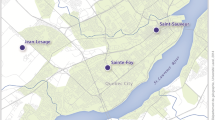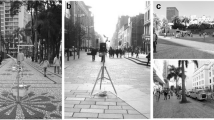Abstract
Thermal effects of the environment are the most prominent environmental influences on the human body. Keeping the body core temperature in a narrow optimum range is the dominating physiological process. Thus, assessing thermal environments has been a major field in biometeorology for many decades, which is also reflected in the number of respective articles and their citations. In the early days of thermal assessments, simple indices only considering a few environmental parameters were used. The next step has been the development of heat budget models describing all relevant heat/energy fluxes to and from the human body. One of the first was PET, which has been presented in the most cited IJBM publication ever (1999). All of these models created by individual scientists have some shortcomings and confinements in their application. In order to overcome such restrictions and to bring the state of the art scientists of thermal modelling together a working group to define a “universal” thermal climate index (UTCI) has been founded, backed and driven by an own commission of the International Society of Biometeorology. This working group has developed a comprehensive open source tool to calculate UTCI for the assessment of outdoor thermal environments for biometeorological applications (see the IJBM special issue 56 (2012) on UTCI).
Similar content being viewed by others
References
Blazejczyk K (1994) New climatological and physiological model of the human heat balance outdoor (MENEX) and its applications in biometeorological studies in different scales. Zeszyty IgiPZ PAN 28:27–58
Blazejczyk K, Epstein Y, Jendritzky G, Staiger H, Tinz B (2012) Comparison of UTCI to selected thermal indices. Int J Biometeorol 56:515–535
Bröde P, Fiala D, Błażejczyk K, Holmér I, Jendritzky G, Kampmann B, Tinz B, Havenith G (2012a) Deriving the operational procedure for the universal thermal climate index (UTCI). Int J Biometeorol 56:481–494
Bröde P, Krüger EL, Rossi FA, Fiala D (2012b) Predicting urban outdoor thermal comfort by the universal thermal climate index UTCI—a case study in southern Brazil. Int J Biometeorol 56:471–480
Büttner K (1938) Physikalische Bioklimatologie. Probleme und Methoden. Akad. Verl. Ges, Leipzig 155 pp
COST UTCI (2004) Towards a Universal Thermal Climate Index UTCI for Assessing the Thermal Environment of the Human Being. MoU of COST Action 730. www.utci.org: 17 pp
De Dear R, Pickup J (2000) An outdoor thermal environment index (OUT_SET*)—Part II—applications. In: De Dear R, Kalma J, Oke T, Auliciems A (eds) Biometeorology and urban climatology at the turn of the millennium. Selected papers from the conference ICB-ICUC’99 (Sydney, 8–12 Nov. 1999). WMO, Geneva, pp 258–290 WCASP-50
De Freitas CR, Grigorieva ES (2015) A comprehensive catalogue and classification of human thermal climate indices. Int J Biometeorol 59(1):109–120
De Freitas CR, Grigorieva ES (2016) A comparison and appraisal of a comprehensive range of human thermal climate indices. Int J Biometeorol 1–26. DOI:10.1007/s00484-016-1228-6
Driscoll DM (1992) Thermal comfort indexes. Current uses and abuses. Nat Weather Digest 17(4):33–38
Fanger PO (1970) Thermal comfort. Analysis and application in environmental engineering. Danish Technical Press, Copenhagen
Fiala D, Havenith G, Bröde P, Kampmann B, Jendritzky G (2012) UTCI-Fiala multi-node model of human heat transfer and temperature regulation. Int J Biometeorol 56:429–441
Gagge AP, Fobelets AP, Berglund PE (1986) A standard predictive index of human response to the thermal environment. ASHRAE Trans 92:709–731
Givoni B (1976) Man, climate and architecture. Appl. Sci. Publishers, London 483 pp
Havenith G, Fiala D, Błazejczyk K, Richards M, Bröde P, Holmér I, Rintamaki H, Benshabat Y, Jendritzky G (2012) The UTCI-clothing model. Int J Biometeorol 56:461–470
Höppe P (1984) Die Energiebilanz des Menschen. Wiss. Mitt. Meteorol. Inst. Uni München, Wiss. Nr. 49
Höppe P (1999) The physiological equivalent temperature—a universal index for the biometeorological assessment of the thermal environment. Int J Biometeorol 43:71–75
Horikoshi T, Tsuchikawa T, Kurazumi Y, Matsubara N (1995) Mathematical expression of combined and seperate effect of air temperature, humidity, air velocity and thermal radiation on thermal comfort. Archives of Complex Environmental Studies 7(3–4):9–12
Jendritzky G, de Dear R (2009) Adaptation and thermal environment. In: Ebi KL, Burton I, GR MG (eds) Biometeorology for adaptation to climate variability and change. Biometeorology 1. Springer, Dordrecht, pp 9–32
Jendritzky G, Sönning W, Swantes HJ (1979) Ein objektives Bewertungsverfahren zur Beschreibung des thermischen Milieus in der Stadt- und Landschaftsplanung (“Klima-Michel-Modell”). Beiträge Akad. Raumforschung Landesplanung, 28, Hannover
Jendritzky G, de Dear R, Havenith G (2012) UTCI—why another thermal index? Int J Biometeorol 56:421–428
Kampmann B, Bröde P, Fiala D (2012) Physiological responses to temperature and humidity compared to the assessment by UTCI, WGBT and PHS. Int J Biometeorol 56:505–513
Landsberg HE (1972) The assessment of human Bioclimate, a limited review of physical parameters. Technical note no. 123, WMO-no. 331. World Meteorological Organization, Geneva
Matzarakis A 2000 Modelling of radiation fluxes in urban areas and their relevance to thermal conditions of humans. Third Symposium on the urban environment. 163–164
Matzarakis A, Rutz F, Mayer H (2007) Modelling radiation fluxes in simple and complex environments—application of the RayMan model. Int J Biometeorol 51:323–334
Pappenberger F, Jendritzky G, Staiger H, Dutra E, Di Giuseppe F, Richardson DS, Cloke HL (2015) Global forecasting of thermal health hazards: the skill of probabilistic predictions of the universal thermal climate index (UTCI). Int J Biometeorol 59:311–324
Parsons KC (2003) Human thermal environments: the effects of hot, moderate, and cold environments on human health, comfort and performance. Taylor & Francis, London
Pickup J, de Dear R (2000) An outdoor thermal comfort index (OUT_SET*)—Part I—the model and its assumptions. In: de Dear R, Kalma J, Oke T, Auliciems A (eds) Biometeorology and urban climatology at the turn of the Millenium. Selected papers from the conference ICB-ICUC’99 (Sydney, 8–12 Nov. 1999). WMO, Geneva, pp 279–283 WCASP-50
Psikuta A, Fiala D, Laschewski G, Jendritzky G, Richards M, Błażejczyk K, Mekjavič I, Rintamäki H, de Dear R, Havenith G (2012) Validation of the Fiala multi-node thermophysiological model for UTCI application. Int J Biometeorol 56:443–460
Sheridan SC, Allen MJ (2017) Sixty years of the International Journal of Biometeorology. Special issue: IJB 60th anniversary, Int J Biometeorol. doi:10.1007/s00484-017-1366-5
Shitzer A, Tikuisis P (2012) Advances, shortcomings, and recommendations for wind chill estimation. Int J Biometeorol 56:495–503
Staiger H, Bucher K, Jendritzky G (1997) Gefühlte Temperatur. Die physiologisch gerechte Bewertung von Wärmebelastung und Kältestress beim Aufenthalt im Freien in der Maßzahl Grad Celsius. Annalen der Meteorologie, Deutscher Wetterdienst, Offenbach 33:100–107
Steadman RG (1984) A universal scale of apparent temperature. J Climate Appl Meteor 23:1674–1687
Steadman RG (1994) Norms of apparent temperature in Australia. Aust Met Mag 43:1–16
Stolwijk JAJ (1971) A mathematical model of physiological temperature regulation in man. NASA contractor report NASA CR-1855, pp. 82, http://ntrs.nasa.gov/archive/nasa/casi.ntrs.nasa.gov/19710023925_1971023925.pdf.
VDI-Guideline 3787-2 (2008) Environmental meteorology. Methods for the human biometeorological evaluation of climate and air quality for urban and regional planning. Verein Deutscher Ingenieure VDI. Part I: climate. Beuth, Berlin
Weihs P, Staiger H, Tinz B, Batchvarova E, Rieder H, Vuilleumier L, Maturilli M, Jendritzky G (2012) The uncertainty of UTCI due to uncertainties in the determination of radiation fluxes derived from measured and observed meteorological data. Int J Biometeorol 56:537–555
WMO, WHO (2015) Heatwaves and Health: Guidance on Warning-System Development. McGregor GR (lead editor), Bessemoulin P, Ebi K, Menne B (eds.) WMO-No 1142, Geneva, 96 pp
Author information
Authors and Affiliations
Corresponding author
Rights and permissions
About this article
Cite this article
Jendritzky, G., Höppe, P. The UTCI and the ISB. Int J Biometeorol 61 (Suppl 1), 23–27 (2017). https://doi.org/10.1007/s00484-017-1390-5
Received:
Revised:
Accepted:
Published:
Issue Date:
DOI: https://doi.org/10.1007/s00484-017-1390-5




